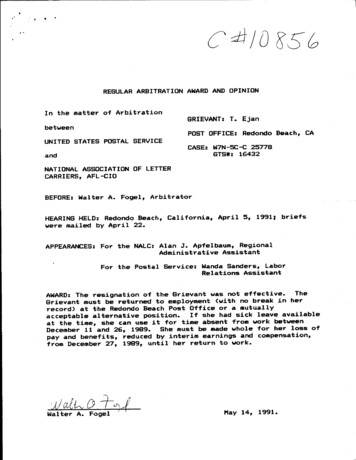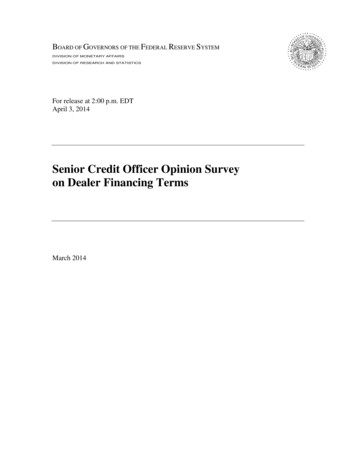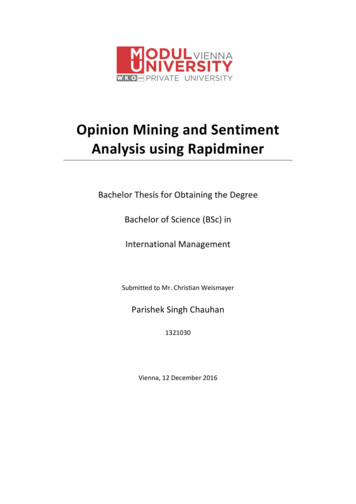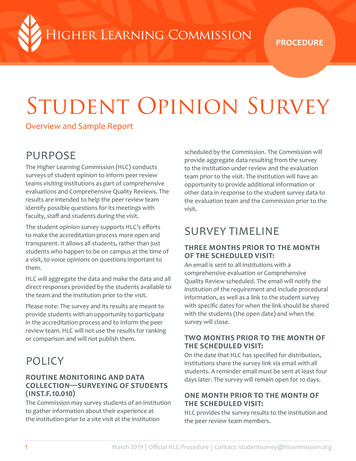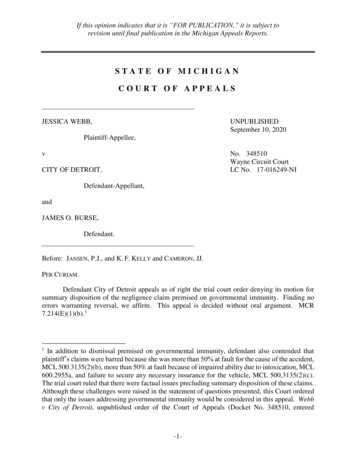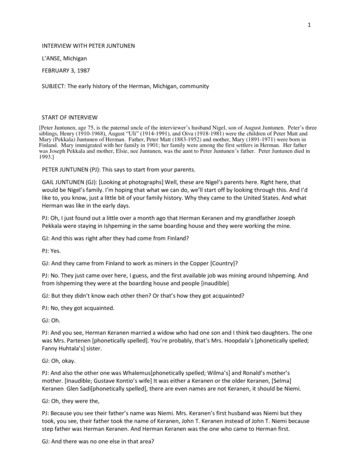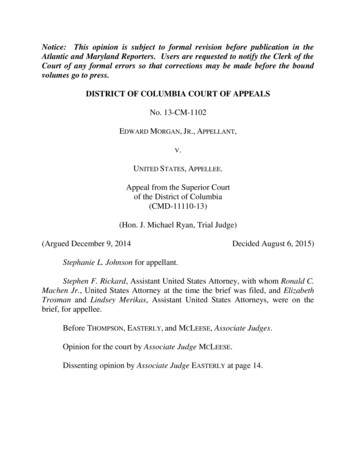
Transcription
Notice: This opinion is subject to formal revision before publication in theAtlantic and Maryland Reporters. Users are requested to notify the Clerk of theCourt of any formal errors so that corrections may be made before the boundvolumes go to press.DISTRICT OF COLUMBIA COURT OF APPEALSNo. 13-CM-1102EDWARD MORGAN, JR., APPELLANT,V.UNITED STATES, APPELLEE.Appeal from the Superior Courtof the District of Columbia(CMD-11110-13)(Hon. J. Michael Ryan, Trial Judge)(Argued December 9, 2014Decided August 6, 2015)Stephanie L. Johnson for appellant.Stephen F. Rickard, Assistant United States Attorney, with whom Ronald C.Machen Jr., United States Attorney at the time the brief was filed, and ElizabethTrosman and Lindsey Merikas, Assistant United States Attorneys, were on thebrief, for appellee.Before THOMPSON, EASTERLY, and MCLEESE, Associate Judges.Opinion for the court by Associate Judge MCLEESE.Dissenting opinion by Associate Judge EASTERLY at page 14.
2MCLEESE, Associate Judge: Appellant Edward Morgan, Jr. challenges hisconviction for possession of cocaine. Mr. Morgan argues that the trial courterroneously denied his motion to suppress evidence. We affirm.I.The United States’s evidence at the suppression hearing indicated thefollowing. On June 29, 2013, at approximately 9:00 p.m., a citizen called thepolice to report potential drug crimes occurring near the citizen’s residence. Afellow officer communicated the citizen’s contact information and location toSergeant James Boteler and Officer Derek Tarr, who went to the citizen’sapartment building and spoke with the citizen. The citizen, who worked for theDepartment of Homeland Security, told the officers that the citizen on more thanone occasion had seen what the citizen believed to be hand-to-hand drugtransactions near the citizen’s apartment. The citizen further explained that, a fewminutes before calling the police, the citizen saw a man on a bicycle exchangesmall objects with another man, after which the two parted ways. During theexchange, the man on the bicycle “reach[ed] into the back of [his] pants andpull[ed] something out [and] put it back in.” The citizen described the man as ashort black male with dreadlocks, riding a red bicycle. The citizen also described
3the color of the man’s shirt; Sergeant Boteler at various points indicated that thecitizen described the man’s shirt as “blue gray,” “purplish gray, or purple slashgray,” or “purple and grayish.”The officers drove around the area looking for the suspect. About ten tofifteen minutes later, the citizen called Sergeant Boteler and said that the man onthe bicycle was in the 1500 block of P Street, NW. Within about thirty seconds,the officers arrived at that location and saw Mr. Morgan, who was riding a redbicycle and matched the description of the suspect. The officers got out of theircar, and Sergeant Boteler asked Mr. Morgan if they could talk to him for a second.Sergeant Boteler told Mr. Morgan that he matched the description of someone whomay have been involved in a drug transaction and asked Mr. Morgan if he had anyillegal drugs on him. Mr. Morgan denied that he did but said that he did have“some K-2 stuff.”Sergeant Boteler knew that “K-2” is a common term forsynthetic cannabinoids and that possession of certain synthetic cannabinoids hasbeen illegal under federal law since 2012. Mr. Morgan told Sergeant Boteler thatSergeant Boteler could search him but that he did not have anything on him.One of the officers took the K-2 out of Mr. Morgan’s pocket. SergeantBoteler ran his hands around Mr. Morgan’s waistband and felt an object below Mr.
4Morgan’s waistband, underneath the back of the pants. At this point, one of theofficers handcuffed Mr. Morgan. After officers tried to persuade Mr. Morgan toremove the drugs from his person, Mr. Morgan reached into the back of his pants,took out a substantial amount of crack cocaine, and dropped it on the ground.Mr. Morgan called his wife as a witness at the suppression hearing. Shetestified that on the date of the arrest she saw Mr. Morgan sitting in a police car,wearing a blue t-shirt and a hat.At the close of the suppression hearing, Mr. Morgan argued that all of theevidence should be suppressed, because the officers unlawfully stopped him inviolation of the Fourth Amendment. Concluding that the stop was justified byreasonable articulable suspicion, the trial court denied the motion to suppress. Thetrial court then found Mr. Morgan guilty after a stipulated trial.II.Mr. Morgan argues that the trial court erred in finding that the officers hadreasonable articulable suspicion to conduct a Terry stop. See Terry v. Ohio, 392
5U.S. 1, 30 (1968) (officers may conduct investigatory stop if they reasonablybelieve “criminal activity may be afoot”). We conclude otherwise.A.When reviewing a trial court’s denial of a motion to suppress, we “mustview the evidence in the light most favorable to the prevailing party.” Bennett v.United States, 26 A.3d 745, 751 (D.C. 2011) (internal quotation marks omitted).We draw all reasonable inferences in favor of upholding the trial court’s ruling.Milline v. United States, 856 A.2d 616, 618 (D.C. 2004). “The police may brieflydetain a person for an investigatory or Terry stop . . . if the officers have areasonable suspicion based on specific and articulable facts that criminal activitymay be occurring.” Pinkney v. United States, 851 A.2d 479, 493 (D.C. 2004)(internal quotation marks omitted). “‘[R]easonable suspicion’ is a less demandingstandard than probable cause and requires a showing considerably less thanpreponderance of the evidence . . . .” Illinois v. Wardlow, 528 U.S. 119, 123(2000); see also, e.g., Immigration & Naturalization Serv. v. Delgado, 466 U.S.210, 217 (1984) (investigative detention requires “some minimal level of objectivejustification”); Robinson v. United States, 76 A.3d 329, 336 (D.C. 2013) (“Thereasonable, articulable suspicion standard requires substantially less than probable
6cause and considerably less than proof of wrongdoing by a preponderance of theevidence. It is not onerous, but it is not toothless either. . . . Unparticularizedsuspicion and inarticulate hunches are not sufficient to sustain a Terry stop . . . .”)(citations and internal quotation marks omitted).B.We conclude that the information provided by the citizen provided theofficers with reasonable articulable suspicion to conduct a Terry stop. We note atthe outset that although the citizen was not named at the suppression hearing, thecitizen provided contact information and spoke to the police in person. The citizenthus was an adequately reliable source of information. See, e.g., Joseph v. UnitedStates, 926 A.2d 1156, 1161 (D.C. 2007) (“[I]nformation from an identified citizenis presumptively reliable.”).1.We conclude that the information provided by the citizen gave rise to areasonable belief that the suspect was involved in unlawful activity. In reachingthis conclusion, we rely on the citizen’s statement that the suspect “reach[ed] into
7the back of [his] pants and pull[ed] something out [and] put it back in” during theexchange of small objects with another man. Interpreted naturally, that statementindicated that the suspect had reached inside the rear of the suspect’s waistband.See, e.g., United States v. Scott, 987 A.2d 1180, 1185-86 (D.C. 2010)(interchangeably referring to “reaching into the back of his pants,” reaching intohis pants, and reaching “into the waistband of his pants”) (internal quotation marksomitted); Mothersell v. Syracuse, 289 F.R.D. 389, 398-99 (N.D.N.Y. 2013)(equating attempt to “reach down into the back of his pants” and “attempt to stickhis fingers inside the waistband of his pants and underwear”); Donaldson v. State,7 A.3d 84, 87, 93 (Md. 2010) (where officer described suspect as pulling plasticbag “from the rear of his pants,” court concludes that “keeping the items in aplastic bag in the rear of his pants was undoubtedly suspicious”). Although it is intheory possible that the citizen meant only to indicate that the suspect reached intoa back pocket, rather than inside the waistband of the suspect’s pants, that does notseem to be the more natural interpretation of the citizen’s words. In any event, theFourth Amendment requires only that the police have a reasonable basis for theiractions, and we conclude that it would be objectively reasonable to understand thecitizen’s statement as indicating that the suspect obtained an object from inside thewaistband of his pants and then returned an object to the same location. Cf., e.g.,United States v. Fury, 554 F.2d 522, 530-31 (2d Cir. 1977) (“The conversations,
8while somewhat ambiguous at times, can be reasonably interpreted to indicatewhat the detective interpreted them to be.”). In arguing to the contrary, the dissentsuggests that ambiguity is fatal to reasonable articulable suspicion. Infra p. 21.The law is otherwise. See, e.g., Wardlow, 528 U.S. at 125 (“Even in Terry, theconduct justifying the stop was ambiguous and susceptible of an innocentexplanation. . . . Terry recognized that the officers could detain the individuals toresolve the ambiguity.”); Umanzor v. United States, 803 A.2d 983, 993 (D.C.2002) (“[T]he Terry standard does not require that an officer rule out thepossibility of innocent behavior, for suspicious conduct by its very nature isambiguous, and the principal function of the investigative stop is to quickly resolvethat ambiguity[.]”) (internal quotation marks omitted).We further conclude that a person’s removal and replacement of an objectfrom inside the waistband of the back of his pants during an exchange willtypically create reasonable articulable suspicion to believe that the suspect wasinvolved in criminal wrongdoing. In the circumstances of this case, we see noplausible, innocent explanation for such conduct. To the contrary, we view suchconduct as comparable to storing objects in the crotch area, which we havedescribed as “a uniquely private part of the body not normally used for carryinglawfully-held personal effects . . . .” Jefferson v. United States, 906 A.2d 885, 888
9(D.C. 2006) (per curiam) (finding probable cause where suspect in high-drug areawho was speaking to another man reached into front crotch area of pants, removedsmall object, examined object, replaced object in crotch area of pants, walked overto nearby car, returned, again removed small object from crotch area, and handedobject to other man). In Jefferson, we found “considerable common sense” in thetrial court’s observation that it could not think of an innocent explanation for“someone exchanging something or giving something from their crotch.” Id. Seealso id. (describing police-officer testimony and prior court decisions noting thatcrotch area was common place to store illegal drugs). When the informationavailable to the police has no plausible innocent explanation, the police have areasonable basis to conduct an investigatory stop. See, e.g., United States v.Saucedo, 226 F.3d 782, 789-90 (6th Cir. 2000) (reasonable articulable suspicion tostop defendant, because “virtually no innocent explanation could have accountedfor all of the activities and circumstances witnessed by the investigators”); State v.Howard, 803 N.E.2d 450, 461-62 (Neb. 2011) (lack of innocent explanation fordefendant’s unusual travel plans weighed heavily in favor of finding of reasonablesuspicion).A number of courts have considered whether police had reasonablearticulable suspicion to conduct a Terry stop based largely or entirely on a
10suspect’s reaching inside his pants to retrieve or display an object. Those courtshave consistently upheld the legality of the Terry stops at issue. See In re AntonioA., 2011 WL 4436459, at *1-2 (Cal. Ct. App. Sept. 26, 2011) (officer hadreasonable articulable suspicion to stop suspect, where suspect, who was in gangarea late at night, grabbed object in his waistband and pulled it back and forth);State v. Johnson, 1996 WL 465419, at *1-2 (Ohio Ct. App. Aug. 14, 1996) (officerhad reasonable articulable suspicion to stop suspect, where suspect, who wasstanding on street corner in high-drug area, took item from his waistband and putitem in back pocket); cf., e.g., W.H. v. State, 928 N.E.2d 288, 294-96 (Ind. Ct. App.2010) (officer had reasonable articulable suspicion to stop suspect, where suspectwas lifting up his shirt and showing object inside waistband to another person; “Itis quite apparent to an experienced police officer, and indeed it may almost beconsidered common knowledge, that a handgun is often carried in the waistband.”)(internal quotation marks omitted); Williams v. State, 717 So. 2d 1109, 1109-10(Fla. Dist. Ct. App. 1998) (officer in high-drug area had probable cause wheresuspect, who was “well known as a street person” and had previously beenarrested, reached below pants into buttocks area, removed a small object,exchanged object for another small object, looked around, and returned objectbeneath his pants).
11The only case we have located that arguably points in the opposite directionis distinguishable, because although the suspect in that case placed a paper baginside his pants, there were no other indications of a drug transaction, whereas thepresent case involves an exchange of small objects out on a street. See State v.Maryland, 771 A.2d 1220, 1229-31 (N.J. 2002) (police lacked reasonablearticulable suspicion to stop suspect who got off train and placed brown paper baginto waistband of sweatpants, which may or may not have had pockets; court notedabsence of testimony as to why officers viewed conduct as suspicious and statedthat there was “nothing suggesting that a drug transaction had taken place”).Similarly, in cases in which this court has found gestures involving objectsinsufficient to support a Terry stop, there were plausible, innocent explanations forthose gestures. See, e.g., In re A.S., 827 A.2d 46, 46-48 (D.C. 2003) (no basis forTerry stop where suspect in high-drug area walked away from police and madestuffing motion in waistband area; court emphasizes that motion “could be theperson’s tucking in his shirt, scratching his side, pulling up his pants, arranging hisunderwear, pager, cell phone, or walkman, etc.”) (internal quotation marksomitted); Duhart v. United States, 589 A.2d 895, 899 (D.C. 1991) (display of“something” to another person without evidence of exchange did not providereasonable articulable suspicion; “there are innumerable innocent explanations for
12such behavior”); In re T.T.C., 583 A.2d 986, 990 (D.C. 1990) (one-way passing ofsmall white object in high-drug area not sufficient basis for reasonable articulablesuspicion; “object may have been illegal drugs or any number of other things”).As we have noted, we do not perceive such an innocent explanation in the presentcase.C.We further conclude that the citizen’s description of the suspect provided asufficient basis to stop Mr. Morgan. The citizen described the suspect as a shortblack male with dreadlocks who was wearing a shirt described at various points assome combination of blue, gray, and purple, and who was riding a red bicycle inthe 1500 block of P Street, NW. When the officers arrived at that location aboutthirty seconds after the citizen’s second call, they saw Mr. Morgan there. Mr.Morgan was riding a red bicycle and, according to the police, matched thedescription provided by the citizen. Those circumstances supported a reasonableconclusion that Mr. Morgan was the suspect. See, e.g., United States v. Turner,699 A.2d 1125, 1126-30 (D.C. 1997) (officers had adequate basis to stop defendantwhere suspect was described as black male wearing blue jacket and blue jeans and
13as being near 1408 Girard Street, and officers responded to location within oneminute and found defendant at stated location matching description).Mr. Morgan argues, however, that there were two discrepancies between hisappearance and the description provided by the citizen: he was wearing a hat whenstopped by the police and his shirt was black.Neither alleged discrepancyundermines articulable suspicion. Although Mr. Morgan’s wife did testify that Mr.Morgan was wearing a hat when she saw him seated in the police car after the stop,that testimony, even if credited, would not establish that Mr. Morgan had beenwearing a hat during the events at issue. And the color of the shirt Mr. Morganwas wearing at the time of the arrest was variously described as “grayish blue orgrayish purple” (Sergeant Boteler) and “blue” (Mr. Morgan’s wife).Incomparison, the testimony indicated that the citizen described the suspect’s shirtcolor as “blue gray,” “purplish gray, or purple slash gray,” or “purple and grayish.”On appeal, Mr. Morgan argues, apparently in reliance upon a police report used forimpeachment at trial, that he was actually wearing a black shirt. Given the manyother distinctive points of similarity, these varying color descriptions do notundermine articulable suspicion. See, e.g., United States v. Atkins, 513 F. App’x577, 580 (6th Cir. 2013) (“[A] minor difference in reported color (silver v.‘tannish’) cannot undermine the validity of a stop supported by other physical
14similarities, as well as temporal and physical proximity to the reported crime.”);see generally Umanzor v. United States, 803 A.2d 983, 996 (D.C. 2002) (“the colordiscrepancy is not dispositive in our assessment of the legality of the Terry stop,”because among other things officer could have reasonably inferred that individualsmistakenly believed dark blue vehicle was gray).1The judgment of the Superior Court is thereforeAffirmed.EASTERLY, Associate Judge, dissenting: No sight of drugs. No sight ofmoney. All the citizen saw was an exchange of small, unidentified objects that thecitizen “believed” was a drug transaction.1Do we now suspend the FourthMr. Morgan also argues that the police questioned him in violation of therequirements of Miranda v. Arizona, 384 U.S. 438 (1966). Neither in the trialcourt nor in this court, however, has Mr. Morgan identified any specificincriminating statement that he believes ought to have been suppressed on Mirandagrounds. Mr. Morgan did acknowledge that he possessed K-2, but that statementwas not relied upon as part of the basis for conviction during the stipulated trial.Under the circumstances, we see no reason to address the Miranda issue. Cf. Statev. Ayson, 129 Wash. App. 1046, at *1-3 (Ct. App. 2005) (unpub. per curiam) (anyerror in failing to suppress statements was harmless in light of other evidence atstipulated trial).
15Amendment’s protection against unreasonable searches and seizures and upholdTerry stops1 based on citizens’ unsupported beliefs?No, the majority opinion says; there is one critical fact that establishes therequisite reasonable articulable suspicion2 to allow the police to lawfully stop Mr.Morgan on the street and investigate whether he was dealing drugs: The citizentold the police that Mr. Morgan “reach[ed] into the back of [his] pants and pull[ed]something out, put it back in.” In other words, the majority opinion’s sole basis forupholding this stop is a citizen’s description of an action one might innocently taketo retrieve from one’s back pocket one’s phone, or wallet, or MetroCard, or workID, or a business card, or a comb, or a tissue, or a cough drop. The majorityopinion concludes, however, that the citizen was not describing anything soinnocuous. Instead, the citizen “naturally” must have meant that he saw Mr.Morgan reaching into the waistband of his pants or even his crotch area. I cannotagree.1Terry v. Ohio, 392 U.S. 1, 19-22 (1968).2See Peay v. United States, 597 A.2d 1318, 1319-20 (D.C. 1991) (en banc).
16When the government seeks to justify a seizure as a permissibleinvestigative detention under the Fourth Amendment pursuant to Terry v. Ohio, itmust demonstrate that there were “specific and articulable facts which, ta
Stephanie L. Johnson for appellant. Stephen F. Rickard, Assistant United States Attorney, with whom Ronald C. Machen Jr., United States Attorney at the time the brief was filed, and Elizabeth Trosman and Lindsey Merikas, Assistant United States Attorneys, were on the brief, for appellee.

